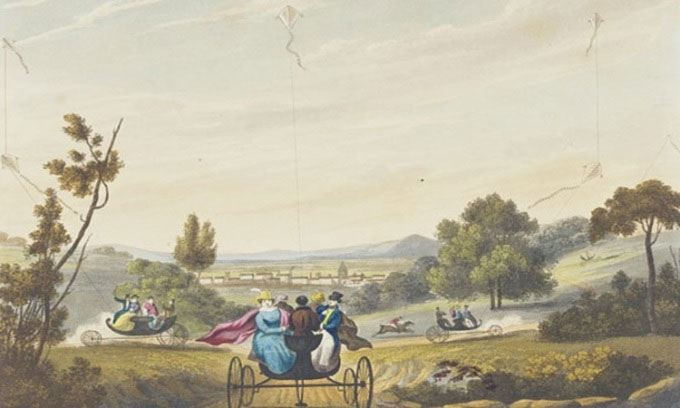Invention of a giant kite-pulled carriage in the 19th century
From his passion for kites, an English teacher invented a carriage pulled by a pair of giant kites, which could run 32km/h in the 19th century.
January 8, 1822 marked a special trip from Bristol to Marlborough. An English teacher named George Pocock took his wife and children on a 182km journey on a carriage pulled by two giant kites instead of horses. Pocock designed the carriage himself and named it "Charvolant," according to Amusing Planet .

Simulation of George Pocock's kite-pulled chariot. (Photo: Amusing Planet).
Pocock has been fascinated with kites since he was a child. While playing and experimenting with kites, he realized that kites have extremely large lifting force. Little Pocock once tied many small stones to the end of the kite string and watched it soar into the air. As Pocock grew older, his experiments became bolder and more dangerous, even including his children. In one experiment, he placed his young daughter on a wicker chair, lifted her up with a kite more than 30 feet high, and then let her fly over the Avon Gorge. Luckily, the girl still survived. At the end of 1824, Pocock let his son fly to the top of a cliff more than 60 meters high on the outskirts of Bristol.
Two years later, Pocock applied for a patent for the Charvolant carriage design. Charvolant consists of two kites on a string 457 - 549 m (about half a kilometer) long, which can pull a carriage carrying several passengers at a relatively fast speed. Steering relies on four control lines attached to the kite and a T-shaped bar that controls the direction of the front wheel. Braking is done by pressing an iron bar against the road surface. Not long after the invention and many adventurous experiments, Pocock published a book describing the experience of traveling by Charvolant. "This type of transportation is the most pleasant of all ," Pocock wrote. "By taking advantage of the wind, the carriage glides quickly across the ground, providing a fast but quiet ride."
According to Pocock, during testing, Charvolant traveled at a speed of 32 km/h over long distances. The carriage can travel 1.6 km in 2.75 minutes, even on congested roads. Because the vehicle's weight is partially supported by the kite, the vehicle glides over any potholes, making the ride less bumpy.
Pocock tried to attract attention from the community with his invention, asserting that Charvolant could run freely through the toll booth because the fee was collected according to the number of horses pulling the cart, but Charvolant did not use any horses. Pocock also promotes many other uses of kites, such as auxiliary propulsion for ships, mooring facilities and rescue from wrecks. Despite his efforts, Charvolant went unnoticed as driving the chariot was not easy. Nevertheless, Pocock and his family continued to use Charvolant for picnics until his death in 1843.
- The life of people in the bottom of society in London in the 19th century
- The life of Saigon in the 19th century through pictures
- Found in the fortress of a 2,000-year-old horse carriage
- X-rays - Great discovery of the 19th century
- 19th century China through rare photos
- Unique inventions in the Rat year
- Objects similar to smartphones in the 19th century painting
- Rare photos of British colonial India in the 19th century
- Photos of life in China in the late 19th century
- What do you know about 19th-century television with
- Discovered two missing ships from the 19th century when searching for MH370
- Modern people are not as intelligent as people of the 19th century?
 Daily use inventions come from universities
Daily use inventions come from universities Special weight loss device helps prevent appetite
Special weight loss device helps prevent appetite 8 inventors were killed by their own inventions
8 inventors were killed by their own inventions Iran invented a motor car powered by water
Iran invented a motor car powered by water